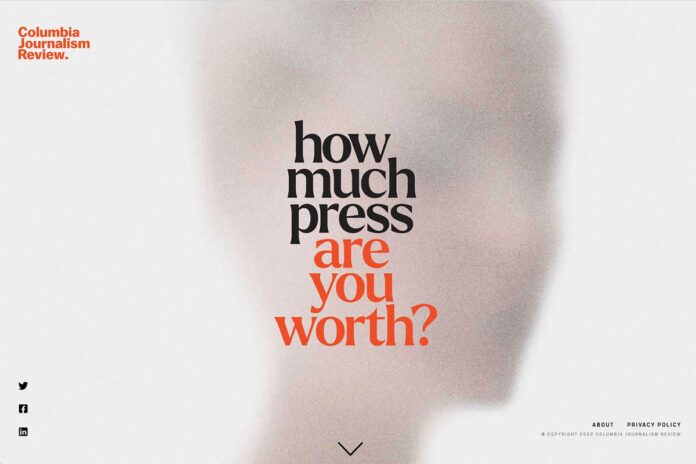If you went missing, how much press would you be ‘worth’? The Columbia Journalism Review unveiled a tool on Thursday that calculates the number of stories your disappearance would net, based on demographics.It sounds morbid but the exercise is designed to call attention to ‘missing white women syndrome,’ the tendency of news organizations to pay relatively little attention to missing people who don’t fit that category.The late journalist Gwen Ifill is credited with coining the term two decades ago. Yet in the interim, there’s been little indication that coverage decisions have evolved.’It’s like a bolt that has been rusted in place,’ said Jelani Cobb, dean of the Columbia Journalism School.The media firestorm around the disappearance and death of Gabby Petito last year renewed scrutiny of the practice, with Petito’s own family imploring media to give all missing people the same attention.Researchers at CJR and the ad agency TBWA/Chiat/Day/New York examined 3,600 stories about missing people done last year by U.S.-based news organizations, cross-referencing them with age, gender and race details from a database maintained by the U.S. Department of Justice.The data was used to generate a rough estimate of how much public attention a person would get based on who they are, said Kyle Pope, CJR’s editor in chief and publisher. The starkly named site AreYouPressworthy.com asks users to enter their age, gender, location and ethnicity.As the site goes through each step, the user is informed that the disappearance of older people and men are less likely to make the news. The tool distinguishes between stories in the local and national press, so people in larger cities – where there are more news outlets – have a ‘higher chance of being reported on than people in rural areas.’ White people are the most likely to get covered, while Black and Hispanic people have the lowest chance of coverage.About 38% of the people who go missing in the United States are Black, more than double the percentage of Black people in the general population, the Black and Missing Foundation says.Black people accounted for 22% of the missing people in the data examined by CJR, and just 13% of the news stories. White people, who made up 47% of the missing person cases, were featured in 70% of the stories.According to the calculator, the disappearance of a 22-year-old white woman in New York would generate 67 stories. If she were three years older, that number would drop to 19. And a missing 25-year-old Black woman from New York would get eight. A 50-year-old Black man in the same city would net six.The results page also identifies the outlets most and least likely to cover the user’s hypothetical disappearance and calculates what percentage of Americans would hear about you. More than 92% of Americans would have heard about a 22-year-old missing white woman from Nevada, the tool says.Why does that matter? ‘When a missing persons’ case is seen by more people, their chances of being found increase,’ the site states.There was no comparable data from when ‘missing white person syndrome’ was first talked about two decades ago.’We have to place a spotlight on the way that the media functions and the way in which we devalue – inadvertently or not – the lives of people that we’re supposed to cover,’ Cobb said.Implicit bias is partly to blame, he said, along with a lack of diversity among journalists in decision-making roles and hard-to-break habits.’There’s clearly an imbalance,’ said Angeline Hartmann, spokesperson for the National Center for Missing & Exploited Children. ‘What needs to happen is the playing field should be leveled.’But Hartmann said there is more than just demographics at play in determining what stories get coverage. The media also gravitates to stories where there are plenty of photos and videos available of the victim – like in Petito’s case – and a family member willing to be an on-camera spokesperson. Those things make journalists’ job easier.Similarly, authorities need to take a close look at how situations are characterized, Hartmann said. Sometimes, she said, people are too simplistically characterized as runaways, and thus not included in stories about missing children.CJR has made similar efforts to call attention to disinformation and coverage of climate control and issues surrounding guns.Pope said he hoped their newest online tool will attract attention on social media, particularly among news consumers who might then put pressure on their local news outlets to keep the issue in mind. Each results page ends with the pictures and names of people who are currently missing and ‘haven’t received any press coverage at all,’ along with an encouragement to contact authorities with any information.’It’s one of the reasons why CJR exists, because we do have the attention of the news industry and we need to use it to point out the problems,’ Pope said. ‘I don’t think another kind of earnest op-ed is going to move the needle.’
New calculator tackles inequality in missing persons stories
Sourceindependent.co.uk
RELATED ARTICLES


